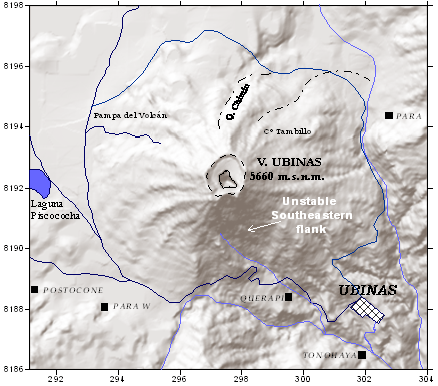Assessment of volcanic hazards at Ubinas, Peru
Vicentina Cruz (1), Marco Rivera (1)
(1). INGEMMET, Dirección de Geología Ambiental. Av. Canadá 1470, San Borja, Lima - Perú.
The volcano Ubinas is a stratovolcano (16º22'S, 70º54'W; 5672m.a s. l.) that is located in the volcanic zone of the Central Andean volcanic zone, a region formed by subduction of the Nazca oceanic plate beneath continental South America.

Ubinas, the most active volcano of Perú. At the moment, present an eruptive activity of fumarolic emissions of ash and gases that only arise in the bottom of the crater current. It is considered as potentially dangerous due to their proximity to towns located in the adjacent valley, being the district of Ubinas located to 6 Km to the South East of crater. A big eventual volcanic eruption would have a catastrophic effect for the 5000 inhabitants of this valley.
From August, 2005 the Ubinas registered a slight increase in its fumarolic activity. March 27, 2006 took place ash fall in the town of Querapi, located to only 4 km to the SE of the volcano. From March, 28 up to April 13 the fumarolic activity was relatively intense.

April 14 at 6:25 pm registered an explosion, followed by a distinguished a gray sulfurous and ash laden eruptive column of gases that rose up to 800 m of height and later fell on the towns of Querapi and Ubinas, affecting to the residents, livestocks and lands of cultivations. Later on, April 20 at 10:50 am a column ashy and gases were generated which ascended up to 3 km high on the border of the caldera which was dispersed to the west. The deposits emitted until April 23 consisted of ashes prepared in layers that measure 6 cm of thickness inside the caldera. Also inside the caldera are distinguished hydrothermally altered blocks that measure up to 70 cm in diameter, probably emitted during April 20. These characteristics suggest that the Ubinas up to April 23 presents a phreati cactivity. The April 27 at 6:30 pm an explosive eruption was reported that emitted incandescent ballistic blocks that ascended beyond 800 m the caldera rim. The May 7 at 6:55 p.m. emitted again incandescent ballistic blocks that ascended beyond 1.7 km the caldera rim These correspond to bombs and scoria of composition andesíte which might suggest the beginning of a vulcanian-type eruption similar to the one exhibited by Ubinas in the year 1677 (Simkin & Siebert, 1994) depositing a flow of gray ash of 1 m of thickness, to 1 km to the west of the crater.
Based on the types of deposits emitted up to April and May we considered that the volcano during a next eruption can present: 1) Tephra-fall, in which two cases are distinguished: emissions of ash and ballistic projections. 2) Lahars, those can be induced by rainstorms. 3) Scoria flows that can be generated by vulcanian eruptions, 4) Rockslide and debris avalanches can be generated by a potential collapse of a part of the south flank of the summit of the volcano, since this flank is thin and fractured.
References: Simkim T. and Siebert L., (1994) - Volcanoes of the World - A Regional Directory, Gazeteer and chronology of volcanism during the last 10,000 year. Smithsonian Institution, Global Volcanism Program, Washington DC.